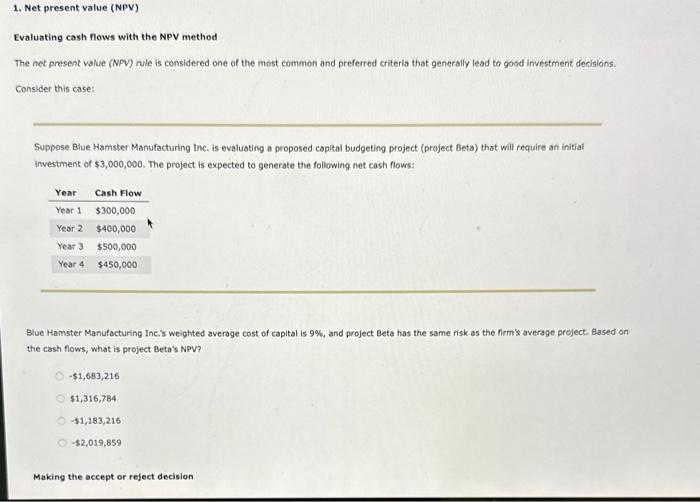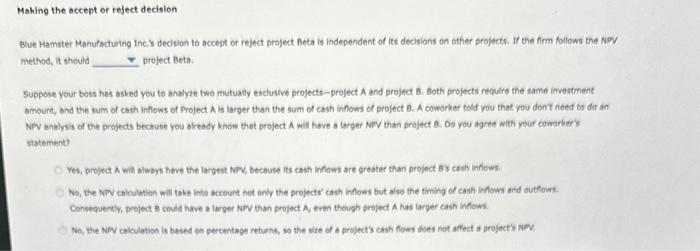legibility is encouraged

1. Net present value (NPV) Evaluating cash flows with the NPV method The net present value (NPV) rule is considered one of the most common and preferred criterla that generally lead to good investment decisions. Consider this case: Suppose Blue Hamster Manufacturing Inc. is evaluating a proposed capital budgeting project (project Beta) that will require an initial Investment of $3,000,000. The project is expected to generote the following net cash flows: Blue Hamster Manufocturing Inci's weighted average cost of capital is 9%, and project Beta has the same risk as the firm's average project. Based on the cash flows, what is project Beta's NPV? $1,683,216$1,316,784$1,183,216$2,019,859 Making the accept or reject decision Making the accept or reject decision Blue Hamster Manufacturing incis decision to accept or reject project Beta is independent of its decitions on other projects. If the firm follows the NPV method, it should project Beta. Suppose your boss has asked you to analyen two mutually exdutlve projects-project A and project B. foth projects require the same investment smount, and the num of cash inhows of Project A is larger than the sum of cash infows of project B. A coworker cold you that you doet need to do an NPV analyas of the projects bectuse you blready know that project A will have a torger NPV than project a. Do you agree with your cowacker's statement? Yes, project A will blways heve the largeit Nov, bectute its cash infows are grester than project Bs cash inflows. Wo, the NPV calculation will take inte account not only the projectr cash inflows but alwo the tining of cash inflows and outhowe. Consequentiy, project B cosid hove a larger Niv than project A, even though project A has larger cash inflows. Blue Hamster Manufacturing Inc.'s decision to accept or reject project Beta is independent of its decisions on other projects. If the fim follows the NipV method, it should project Beta. Suppose your bor 1 you to analyze two mutually exclusive projects-project A and project B. Both projects require the same investment. amount, and the I innlows of Project A is larger than the sum of cash inflows of project B. A coworker told you that you dont need to do an NPV analysis of t... ... be.. because you already know that project A will have a larger NPV than project B. Do you agree with your coworker's statement? Yes, project A will always have the largest NPV, because its cash inflows are greater than project B's cash inflows. No, the NFV calculation wili take into account not only the projects' cash inflews but also the timing of cash inflows and outflows. Consequentyy, project B could have a larger NPV than project A, even though project A has larger cash inflows. No, the NPV calculation is based on percentage returns, so the size of a project's cash flows does not affect a project's NDV










